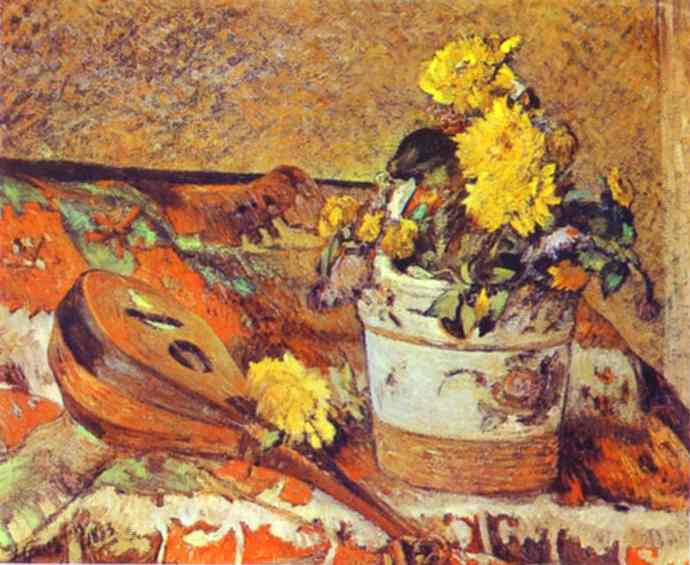Description
Paul Gauguin's "Mandolin and Flowers," created in 1883, is a representative example of the artist's post-impressionist style, which is characterized by an emotive exploration of color and form, as well as an interest in the synthesis of visual elements. In this painting, Gauguin presents a carefully crafted approach to the depiction of everyday objects, which take on an air of transcendence and symbolism.
In the painting, the lack of human characters invites us to reflect on the relationship between objects and the aesthetics of the environment that surrounds them. The mandolin, placed in the center, is the protagonist that seems to float in the pictorial space, highlighting its curvilinear and delicate silhouette. This instrument, which embodies a sense of harmony and musicality, is surrounded by exuberant flowers, which together suggest a celebration of life and beauty. Gauguin uses a vibrant color scheme: yellows, oranges and greens predominate, contrasting with darker shades that outline the shadows of the objects.
The composition is dynamic and is wrapped in an atmosphere that seems to distill the essence of the tropical areas that Gauguin came to inhabit later in his career. However, in this work, there is a clear influence of French culture and art, which places Gauguin at a turning point between tradition and exploration into less conventional territories. The use of color is not merely descriptive; it reflects emotions and sensations that go beyond mere representation. The vibrant palette suggests a personal interpretation of the environment, far removed from the strict naturalism that had dominated art prior to Impressionism.
The flower vases and some of the accompanying items on the mandolin are not merely decorative. Throughout art history, everyday objects have been used to explore deeper meanings. In this case, the fusion of the mandolin with the flowers evokes a dialogue between nature and human creativity. The fluid use of colour and the emotional charge of the pictorial space encourage the idea that these objects are imbued with a sense of life and expression, suggesting that, although there is no human presence, the work encapsulates the spirit of artistic creation itself.
It is important to contextualize "Mandolin and Flowers" within Gauguin's own evolution. During this early period of his career, before his famous time in Tahiti, Gauguin was already exploring his concerns about the essence of painting as a means of expressing the artist's subjectivity. This work is notable for its ability to capture the essence of his thinking, as well as the broader influences of Impressionism, while beginning to outline a path toward a more symbolic and less representational style that would manifest itself more prominently in his later works.
"Mandolin and Flowers" is an invitation to appreciate the world from a more emotional and subjective perspective. Some critics have pointed out that the emphasis on form and color suggests a movement toward something that transcends mere representation, something that would resonate strongly in his future works. Thus, this piece not only acts as a reflection of Gauguin's talent at a crucial moment in his artistic development, but it also cannot be appreciated without recognizing the broader context of the evolution of post-impressionist art, of which he was a fundamental figure.
KUADROS ©, a famous painting on your wall.
Hand-made oil painting reproductions, with the quality of professional artists and the distinctive seal of KUADROS ©.
Painting reproduction service with satisfaction guarantee. If you are not completely satisfied with the replica of your painting, we will refund 100% of your money.

